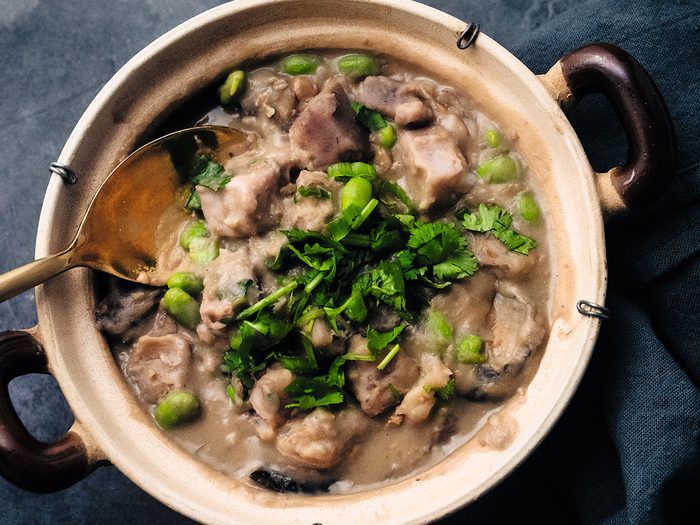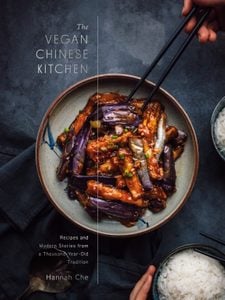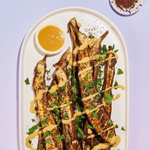This Coconut Clay Pot Taro & Edamame Is the Vegan Dish You Need This Season

A recipe for a hot and hearty bowl, excerpted from the cookbook The Vegan Chinese Kitchen by Hannah Che
Although taro is often associated in the West with creamy sweet drinks and desserts, its delicious appeal is most obvious in savory dishes. The purple-mottled flesh cooks down to fragrant, meaty bites with a fine-textured starchiness, a quality called 麵 miàn, or “floury,” and a stick-to-the-roof-of-your-mouth savoriness reminiscent of a hard-boiled egg yolk. This was one of my favorite menu items at Gudian Meiren, a vegetarian restaurant in Taipei, where it was featured alongside other dishes like seitan “ribs” skewered on sugarcane with a tangy hibiscus reduction, braised tofu with bamboo shoots, and crisp roast “duck” on a bed of puffed rice. You won’t find coconut milk used traditionally in most regional Chinese cuisines (with the exception of Hainanese), but the influence of South Asian cuisines on modern Chinese cooking can be seen in the growing popularity of dishes with coconut milk, like this one.
(Related: You’re Seriously Underusing Your Rice Cooker)
Coconut Clay Pot Taro & Edamame
Yēxiāng yùtóu bāo
椰香芋頭煲
Serves 4
Ingredients
- 4 large dried shiitake mushrooms
- 1 cup (240 mL) boiling water
- 1 medium (10 ounces / 280 grams) taro root
- 3 tablespoons Shallot Oil or vegetable oil, divided
- 1 (2-inch) piece (15 grams) ginger, unpeeled, washed and thinly sliced
- 3 garlic cloves, minced
- 2 tablespoons fermented soybean paste
- 1 cup cooked shelled edamame, thawed if frozen
- 1 cup (240 mL) unsalted stock of any kind or water
- ½ cup full-fat coconut milk
- 1 tablespoon sugar
- ½ teaspoon kosher salt, plus more to taste
- ¼ teaspoon ground white pepper
- Handful of fresh cilantro, both stems and leaves finely chopped
Directions
In a small bowl, cover the mushrooms with the boiling water and place another bowl or plate on top to weigh them down. Soak for 30 minutes.
Meanwhile, peel the taro and cut it into 1-inch cubes. In a skillet or wok, heat 2 tablespoons of the shallot oil over medium-high heat until shimmering and then add the taro. Sear the taro in the hot oil, flipping occasionally, until golden brown on the edges, about 4 minutes.
Remove from the pan.
Drain the shiitake mushrooms, reserving the soaking liquid, snip off and discard the stems, and cut the caps on a diagonal into 3 or 4 thin slices each. Set a clay pot on or return the wok to the stovetop over medium-low heat and heat the remaining 1 tablespoon shallot oil until it shimmers.
Add the ginger and mushrooms and stir-fry until the edges of the mushrooms start to brown and stick, about 3 minutes. Add the garlic and fermented bean paste and stir-fry until most of the moisture has sizzled out of the paste and it smells delicious, about 20 seconds. Add the cooked taro and edamame, then pour in the stock and coconut milk. Season with sugar and salt to taste—this will depend on the saltiness of your soybean paste.
Cover and cook for 15 to 18 minutes, until the taro has absorbed most of the liquid and is completely cooked through and fork-tender. Add the white pepper, top with the cilantro, and serve immediately.

Excerpted from The Vegan Chinese Kitchen by Hannah Che. Copyright © 2022 Hannah Che. Photographs by Hannah Che. Published by Appetite by Random House®, a division of Penguin Random House Canada Limited. Reproduced by arrangement with the Publisher. All rights reserved.
Next: Shake Up Your Lunch With This Napa Cabbage & Vermicelli Salad




